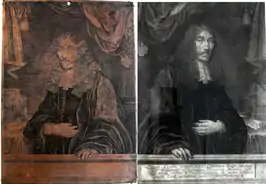Chalcography
Chalcography (from Ancient Greek χαλκός, chalcos, meaning copper, and γράφειν, graphein, meaning 'to write'), are engravings on copper plates used for printmaking and illustrations, although the term has also been used of engravings on any type of metal.[1][2][3] The Monte dei Santi di Dio by Antonio Bettini is the most ancient book bearing chalcographies, printed in Florence on September 10, 1477 from Nicolo di Lorenzo Tedesco. Its primacy is contested by Ptolemy's Cosmographia, printed in Bologna on June 23, 1477 from Domenico de' Lapi, a Latin translation from Jacopo d'Angelo, containing geographical charts and maps by Taddeo Crivelli, engraved in copper plates.

Chalcography technology, plate of German poeta laureatus Ambrosius Hannemann (died in 1644)
See also
References
- Béguin, André. "Chalcography". Printmaking dictionary. Retrieved 9 July 2020.
- "Chalcography Workshop". Museo Picasso Málaga. Retrieved 9 July 2020.
- "Chalcography workshop". Boutiques de Musées. Retrieved 9 July 2020.
This article is issued from Wikipedia. The text is licensed under Creative Commons - Attribution - Sharealike. Additional terms may apply for the media files.